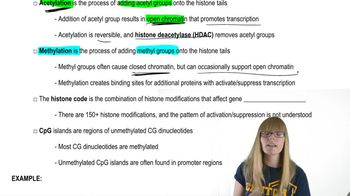Table of contents
- 1. Introduction to Genetics51m
- 2. Mendel's Laws of Inheritance3h 37m
- 3. Extensions to Mendelian Inheritance2h 41m
- 4. Genetic Mapping and Linkage2h 28m
- 5. Genetics of Bacteria and Viruses1h 21m
- 6. Chromosomal Variation1h 48m
- 7. DNA and Chromosome Structure56m
- 8. DNA Replication1h 10m
- 9. Mitosis and Meiosis1h 34m
- 10. Transcription1h 0m
- 11. Translation58m
- 12. Gene Regulation in Prokaryotes1h 19m
- 13. Gene Regulation in Eukaryotes44m
- 14. Genetic Control of Development44m
- 15. Genomes and Genomics1h 50m
- 16. Transposable Elements47m
- 17. Mutation, Repair, and Recombination1h 6m
- 18. Molecular Genetic Tools19m
- 19. Cancer Genetics29m
- 20. Quantitative Genetics1h 26m
- 21. Population Genetics50m
- 22. Evolutionary Genetics29m
17. Mutation, Repair, and Recombination
DNA Repair
Problem 36c
Textbook Question
A geneticist searching for mutations uses the restriction endonucleases SmaI and PvuII to search for mutations that eliminate restriction sites. SmaI will not cleave DNA with CpG methylation. It cleaves DNA at the restriction digestion sequence ↓ 5′−CCC GGG−3′ 3′−GGG CCC−3′ ↑ PvuII is not sensitive to CpG methylation. It cleaves DNA at the restriction sequence ↓ 5′−CAG CTG−3′ 3′−GTC GAC−5′ ↑ Explain why CpG dinucleotides are hotspots of mutation.
 Verified step by step guidance
Verified step by step guidance1
CpG dinucleotides are hotspots of mutation because the cytosine (C) in CpG sequences is often methylated to form 5-methylcytosine. This methylation is a normal epigenetic modification that plays a role in gene regulation.
5-methylcytosine is chemically unstable and prone to spontaneous deamination. When deamination occurs, the 5-methylcytosine is converted into thymine (T), resulting in a C-to-T transition mutation.
The repair mechanisms in the cell may fail to recognize this mutation because the resulting T pairs with A during DNA replication, making the mutation permanent if not corrected.
CpG dinucleotides are underrepresented in the genome because of this high mutation rate. However, they are still critical in regulatory regions, and mutations in these sites can have significant effects on gene expression and function.
In the context of the problem, the presence of CpG methylation can prevent the SmaI enzyme from cleaving DNA at its recognition site, which could be used to detect mutations that eliminate or alter CpG sites.
 Verified video answer for a similar problem:
Verified video answer for a similar problem:This video solution was recommended by our tutors as helpful for the problem above
Video duration:
7mPlay a video:
Was this helpful?
Key Concepts
Here are the essential concepts you must grasp in order to answer the question correctly.
CpG Dinucleotides
CpG dinucleotides are pairs of cytosine (C) and guanine (G) nucleotides linked by a phosphate bond, often found in the promoter regions of genes. They are significant in gene regulation and are typically subject to methylation, which can silence gene expression. The methylation of cytosine in CpG sites can lead to deamination, converting methylated cytosine to thymine, thus creating mutations.
Recommended video:
Guided course

Histone Protein Modifications
Methylation and Mutation
Methylation is a biochemical process where a methyl group is added to the DNA molecule, often affecting gene expression without altering the sequence. In the context of CpG dinucleotides, methylation can lead to instability and increased mutation rates, as the deamination of 5-methylcytosine is more likely to occur than that of unmethylated cytosine, resulting in a higher frequency of mutations in these regions.
Recommended video:
Guided course

Mutations and Phenotypes
Restriction Endonucleases
Restriction endonucleases are enzymes that cut DNA at specific sequences, which can be used to analyze genetic material. Different enzymes have varying sensitivities to DNA modifications, such as methylation. For instance, SmaI is inhibited by methylation at CpG sites, while PvuII is not, making these enzymes useful tools for identifying mutations that affect restriction sites and understanding the role of methylation in mutation hotspots.
Recommended video:
Guided course

Mapping with Markers
Related Videos
Related Practice
Textbook Question
When a double-strand DNA break occurs in a eukaryotic cell, it may be repaired by either nonhomologous end joining or homologous recombination. How do these different repair mechanisms lead to potentially different outcomes?
910
views


